GH30-7 Endoxylanase C from the Filamentous Fungus Talaromyces cellulolyticus
- PMID: 31492671
- PMCID: PMC6821971
- DOI: 10.1128/AEM.01442-19
GH30-7 Endoxylanase C from the Filamentous Fungus Talaromyces cellulolyticus
Abstract
Glycoside hydrolase family 30 subfamily 7 (GH30-7) enzymes include various types of xylanases, such as glucuronoxylanase, endoxylanase, xylobiohydrolase, and reducing-end xylose-releasing exoxylanase. Here, we characterized the mode of action and gene expression of the GH30-7 endoxylanase from the cellulolytic fungus Talaromyces cellulolyticus (TcXyn30C). TcXyn30C has a modular structure consisting of a GH30-7 catalytic domain and a C-terminal cellulose binding module 1, whose cellulose-binding ability has been confirmed. Sequence alignment of GH30-7 xylanases exhibited that TcXyn30C has a conserved Phe residue at the position corresponding to a conserved Arg residue in GH30-7 glucuronoxylanases, which is required for the recognition of the 4-O-methyl-α-d-glucuronic acid (MeGlcA) substituent. TcXyn30C degraded both glucuronoxylan and arabinoxylan with similar kinetic constants and mainly produced linear xylooligosaccharides (XOSs) with 2 to 3 degrees of polymerization, in an endo manner. Notably, the hydrolysis of glucuronoxylan caused an accumulation of 22-(MeGlcA)-xylobiose (U4m2X). The production of this acidic XOS is likely to proceed via multistep reactions by putative glucuronoxylanase activity that produces 22-(MeGlcA)-XOSs (X n U4m2X, n ≥ 0) in the initial stages of the hydrolysis and by specific release of U4m2X from a mixture containing X n U4m2X. Our results suggest that the unique endoxylanase activity of TcXyn30C may be applicable to the production of linear and acidic XOSs. The gene xyn30C was located adjacent to the putative GH62 arabinofuranosidase gene (abf62C) in the T. cellulolyticus genome. The expression of both genes was induced by cellulose. The results suggest that TcXyn30C may be involved in xylan removal in the hydrolysis of lignocellulose by the T. cellulolyticus cellulolytic system.IMPORTANCE Xylooligosaccharides (XOSs), which are composed of xylose units with a β-1,4 linkage, have recently gained interest as prebiotics in the food and feed industry. Apart from linear XOSs, branched XOSs decorated with a substituent such as methyl glucuronic acid and arabinose also have potential applications. Endoxylanase is a promising tool in producing XOSs from xylan. The structural variety of XOSs generated depends on the substrate specificity of the enzyme as well as the distribution of the substituents in xylan. Thus, the exploration of endoxylanases with novel specificities is expected to be useful in the provision of a series of XOSs. In this study, the endoxylanase TcXyn30C from Talaromyces cellulolyticus was characterized as a unique glycoside hydrolase belonging to the family GH30-7, which specifically releases 22-(4-O-methyl-α-d-glucuronosyl)-xylobiose from hardwood xylan. This study provides new insights into the production of linear and branched XOSs by GH30-7 endoxylanase.
Keywords: Talaromyces cellulolyticus; endoxylanase; glycoside hydrolase family 30; lignocellulose; xylan; xylooligosaccharide.
Copyright © 2019 American Society for Microbiology.
Figures

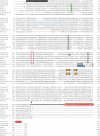
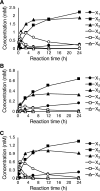

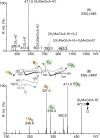

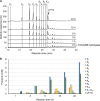
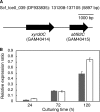
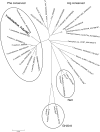

Similar articles
-
Crystal structure of GH30-7 endoxylanase C from the filamentous fungus Talaromyces cellulolyticus.Acta Crystallogr F Struct Biol Commun. 2020 Aug 1;76(Pt 8):341-349. doi: 10.1107/S2053230X20009024. Epub 2020 Jul 28. Acta Crystallogr F Struct Biol Commun. 2020. PMID: 32744245 Free PMC article.
-
Mode of Action of GH30-7 Reducing-End Xylose-Releasing Exoxylanase A (Xyn30A) from the Filamentous Fungus Talaromyces cellulolyticus.Appl Environ Microbiol. 2019 Jun 17;85(13):e00552-19. doi: 10.1128/AEM.00552-19. Print 2019 Jul 1. Appl Environ Microbiol. 2019. PMID: 31003983 Free PMC article.
-
Structural and functional characterization of a bifunctional GH30-7 xylanase B from the filamentous fungus Talaromyces cellulolyticus.J Biol Chem. 2019 Mar 15;294(11):4065-4078. doi: 10.1074/jbc.RA118.007207. Epub 2019 Jan 17. J Biol Chem. 2019. PMID: 30655295 Free PMC article.
-
Xylanases of glycoside hydrolase family 30 - An overview.Biotechnol Adv. 2021 Mar-Apr;47:107704. doi: 10.1016/j.biotechadv.2021.107704. Epub 2021 Feb 3. Biotechnol Adv. 2021. PMID: 33548454 Review.
-
Endo-xylanases as tools for production of substituted xylooligosaccharides with prebiotic properties.Appl Microbiol Biotechnol. 2018 Nov;102(21):9081-9088. doi: 10.1007/s00253-018-9343-4. Epub 2018 Sep 8. Appl Microbiol Biotechnol. 2018. PMID: 30196329 Free PMC article. Review.
Cited by
-
Yeast GH30 Xylanase from Sugiyamaella lignohabitans Is a Glucuronoxylanase with Auxiliary Xylobiohydrolase Activity.Molecules. 2022 Jan 25;27(3):751. doi: 10.3390/molecules27030751. Molecules. 2022. PMID: 35164030 Free PMC article.
-
Characterization of a novel GH30 non-specific endoxylanase AcXyn30B from Acetivibrio clariflavus.Appl Microbiol Biotechnol. 2024 Apr 29;108(1):312. doi: 10.1007/s00253-024-13155-w. Appl Microbiol Biotechnol. 2024. PMID: 38683242 Free PMC article.
-
The first crystal structure of a xylobiose-bound xylobiohydrolase with high functional specificity from the bacterial glycoside hydrolase family 30, subfamily 10.FEBS Lett. 2022 Sep;596(18):2449-2464. doi: 10.1002/1873-3468.14454. Epub 2022 Aug 4. FEBS Lett. 2022. PMID: 35876256 Free PMC article.
-
Use of xylosidase 3C from Segatella baroniae to discriminate xylan non-reducing terminus substitution characteristics.BMC Res Notes. 2024 Jun 24;17(1):175. doi: 10.1186/s13104-024-06835-3. BMC Res Notes. 2024. PMID: 38915023 Free PMC article.
-
Crystal structure of GH30-7 endoxylanase C from the filamentous fungus Talaromyces cellulolyticus.Acta Crystallogr F Struct Biol Commun. 2020 Aug 1;76(Pt 8):341-349. doi: 10.1107/S2053230X20009024. Epub 2020 Jul 28. Acta Crystallogr F Struct Biol Commun. 2020. PMID: 32744245 Free PMC article.
References
-
- Samanta AK, Jayapal N, Jayaram C, Roy S, Kolte AP, Senani S, Sridhar M. 2015. Xylooligosaccharides as prebiotics from agricultural by-products: production and applications. Bioact Carbohydr Diet Fibre 5:62–71. doi:10.1016/j.bcdf.2014.12.003. - DOI
-
- Moure A, Gullón P, Domínguez H, Parajó JC. 2006. Advances in the manufacture, purification and applications of xylo-oligosaccharides as food additives and nutraceuticals. Process Biochem 41:1913–1923. doi:10.1016/j.procbio.2006.05.011. - DOI
Publication types
MeSH terms
Substances
LinkOut - more resources
Full Text Sources

